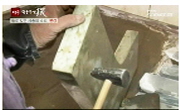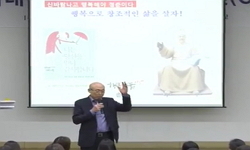King Sejong regarded the reorganization of Confucian rites, music, and the managerial system as a task of upmost importance. To achieve this, experts who studied the theoretical basis of the related fields and acquired practical abilities to carry out...
http://chineseinput.net/에서 pinyin(병음)방식으로 중국어를 변환할 수 있습니다.
변환된 중국어를 복사하여 사용하시면 됩니다.
- 中文 을 입력하시려면 zhongwen을 입력하시고 space를누르시면됩니다.
- 北京 을 입력하시려면 beijing을 입력하시고 space를 누르시면 됩니다.
https://www.riss.kr/link?id=A107746060
- 저자
- 발행기관
- 학술지명
- 권호사항
-
발행연도
2021
-
작성언어
-
-
주제어
집현전 ; 集賢殿 ; 세종 ; 世宗 ; 경연 ; 經筵 ; 장기근속 ; 이차천전 ; 以次遷轉 ; Jiphyeonjeon ; Hall of Worthies ; King Sejong ; Gyeongyeon ; Royal Lecture ; Long-Term Service ; Promotion by Seniority
-
KDC
0
-
등재정보
KCI등재
-
자료형태
학술저널
-
수록면
163-203(41쪽)
-
KCI 피인용횟수
0
- 제공처
- 소장기관
-
0
상세조회 -
0
다운로드
부가정보
다국어 초록 (Multilingual Abstract)
Personnel management in Jiphyeonjeon was characterized by the systems of long-term service and promotion by seniority. The officials of Jiphyeonjeon kept the same position for many years to focus on studying their specialties. Sejong stressed that the sole purpose of Jiphyeonjeon was to author major state documents. and therefore required the scholars to concentrate on life-long study. The officials were promoted according to the order of hire, and this system was considered to be the custom of Jiphyeonjeon. They followed the rule of seniority of official employment and age, so they could respect superior Confucian scholars. Through these processes, Jiphyeonjeon and Gyeongyeon became the preeminent scholarly research institutions. In Gyeongyeon, Sejong and the officials recited Confucius texts of Four Books and Five Classics, as well as history books such as Zizhitongjian and Xinglidaquan. They did not stop at mere reading, but reached a level of scholarly studying by adding annotations. Intellectual achievements in Gyeongyeon served as the foundations for the rearrangement of rituals and music, and the reorganization of various institutions. Conclusively, Jiphyeonjeon can be understood as the royal institution where selected officials from the highest civil service examination, nurtured by long-term engagements in Gyeongyeon, were raised as competent intellectuals, and provided administrative counsel for state management upon the requests of the royal court.
King Sejong regarded the reorganization of Confucian rites, music, and the managerial system as a task of upmost importance. To achieve this, experts who studied the theoretical basis of the related fields and acquired practical abilities to carry out governmental projects were required. To nurture the foundation of academic research and educate intellectuals, King Sejong utilized two institutions: Gyeongyeon (royal lecture) and Jiphyeonjeon (Hall of Worthies). These two, maintaining close relations with one another, played a crucial role in the study of Confucian rituals and systems during the Sejong era. Sejong added a new function to Jiphyeonjeon, which was the upbringing of pupils. Jiphyeonjeon selected young and capable civil officials and had them advise the King by discussing classics and histories. The King founded salary posts in Jiphyeonjeon in 1420 and had those in the posts hold the positions of Gyeongyeongwan (royal lecturer) as well. The total number of Jiphyeonjeon officials differed, from 10, 32, or 20 at times, but the responsibility of being responsible for Gyeongyeon and Seoyeon (lecture for the Crown Prince) and for authoring major state documents were maintained as their own by tradition.
Personnel management in Jiphyeonjeon was characterized by the systems of long-term service and promotion by seniority. The officials of Jiphyeonjeon kept the same position for many years to focus on studying their specialties. Sejong stressed that the sole purpose of Jiphyeonjeon was to author major state documents. and therefore required the scholars to concentrate on life-long study. The officials were promoted according to the order of hire, and this system was considered to be the custom of Jiphyeonjeon. They followed the rule of seniority of official employment and age, so they could respect superior Confucian scholars. Through these processes, Jiphyeonjeon and Gyeongyeon became the preeminent scholarly research institutions. In Gyeongyeon, Sejong and the officials recited Confucius texts of Four Books and Five Classics, as well as history books such as Zizhitongjian and Xinglidaquan. They did not stop at mere reading, but reached a level of scholarly studying by adding annotations. Intellectual achievements in Gyeongyeon served as the foundations for the rearrangement of rituals and music, and the reorganization of various institutions. Conclusively, Jiphyeonjeon can be understood as the royal institution where selected officials from the highest civil service examination, nurtured by long-term engagements in Gyeongyeon, were raised as competent intellectuals, and provided administrative counsel for state management upon the requests of the royal court.
참고문헌 (Reference)
1 "한국고전종합DB"
2 박홍갑, "집현전 학사 최만리의 정치활동" 한국고전번역원 37 (37): 193-220, 2011
3 "조선왕조실록"
4 손유경, "세종조 집현전 학사의 교유 양상 연구 - 진관사 사가독서 참여인을 중심으로 -" 한국한문고전학회 37 (37): 103-142, 2018
5 구만옥, "세종시대의 과학기술" 들녘 2016
6 손보기, "세종대왕과 집현전" 세종대왕기념사업회 1984
7 "高麗史"
8 成大中, "靑城雜記"
9 兪英玉, "集賢殿의 運營과 思想的 傾向 — 性理學 理解를 中心으로 —" 釜山大學校 18 : 1994
10 李載喆, "集賢殿의 機能에 대한 硏究" 연세대학교 인문학연구원(延世大學校 文科大學) 30 : 1973
1 "한국고전종합DB"
2 박홍갑, "집현전 학사 최만리의 정치활동" 한국고전번역원 37 (37): 193-220, 2011
3 "조선왕조실록"
4 손유경, "세종조 집현전 학사의 교유 양상 연구 - 진관사 사가독서 참여인을 중심으로 -" 한국한문고전학회 37 (37): 103-142, 2018
5 구만옥, "세종시대의 과학기술" 들녘 2016
6 손보기, "세종대왕과 집현전" 세종대왕기념사업회 1984
7 "高麗史"
8 成大中, "靑城雜記"
9 兪英玉, "集賢殿의 運營과 思想的 傾向 — 性理學 理解를 中心으로 —" 釜山大學校 18 : 1994
10 李載喆, "集賢殿의 機能에 대한 硏究" 연세대학교 인문학연구원(延世大學校 文科大學) 30 : 1973
11 崔承熙, "集賢殿硏究(下)— 置廢始末과 機能分析 —" 歷史學會 33 : 1967
12 崔承熙, "集賢殿硏究(上)— 置廢始末과 機能分析 —" 歷史學會 32 : 1966
13 姜文植, "集賢殿 출신 官人의 學問觀과 政治觀" 서울大學校 人文大學 國史學科 39 : 1998
14 鄭杜熙, "集賢殿 學士 硏究" 全北大學校 史學會 4 : 1980
15 한충희, "朝鮮初期 集賢殿官硏究" 朝鮮史硏究會 16 : 2007
16 崔承熙, "朝鮮初期 言官에 관한 硏究 — 集賢殿官의 言官化 —" 서울大學校 人文大學 國史學科 1 : 1973
17 鄭杜熙, "朝鮮初期 政治支配勢力硏究"
18 韓亨周, "朝鮮 世宗代의 古制硏究에 대한 考察" 歷史學會 136 : 1992
19 李瀷, "星湖僿說"
20 "成宗實錄"
21 崔鉉培先生 還甲記念 論文集刊行會, "崔鉉培 先生 還甲記念論文集" 思想界社 1954
22 "定宗實錄"
23 "太祖實錄"
24 "太宗實錄"
25 "大東野乘"
26 "國朝文科榜目"
27 徐居正, "四佳集"
28 "世宗實錄"
동일학술지(권/호) 다른 논문
-
화해 없는 통일? ― 1975년 이후 베트남의 사회적 갈등과 통합
- 서울대학교 인문학연구원
- 마틴그로스하임 ( Martin Grossheim )
- 2021
- KCI등재
-
‘주사위 노름’으로 오해되는 고대 인도의 내기에 대한 해명 ― 베다시기 견과윷(akṣa) 경기와 『릭베다』(Ṛgveda)의 “견과윷 노래”(Akṣa-sūkta)를 중심으로
- 서울대학교 인문학연구원
- 강성용 ( Kang Sung Yong )
- 2021
- KCI등재
-
푸생의 회화에서 음조와 정조 ― 그의 음악적 유비에 대하여
- 서울대학교 인문학연구원
- 정우진 ( Chung Woo-jin )
- 2021
- KCI등재
-
갑오·대한제국기 사법개혁에 대한 실증적 재해석 [서평] 이승일(2021), 『근대 한국의 법, 재판 그리고 정의』, 경인문화사, 428쪽.
- 서울대학교 인문학연구원
- 심재우
- 2021
- KCI등재
분석정보
인용정보 인용지수 설명보기
학술지 이력
| 연월일 | 이력구분 | 이력상세 | 등재구분 |
|---|---|---|---|
| 2026 | 평가예정 | 재인증평가 신청대상 (재인증) | |
| 2020-01-01 | 평가 | 등재학술지 유지 (재인증) |  |
| 2017-01-01 | 평가 | 등재학술지 유지 (계속평가) |  |
| 2015-01-07 | 학회명변경 | 영문명 : Seoul National University Institute of Humanities -> Institute of Humanities, Seoul National University |  |
| 2015-01-06 | 학술지명변경 | 외국어명 : Seoul National University the Journal of Humanites -> Journal of Humanities, Seoul National University |  |
| 2013-01-01 | 평가 | 등재 1차 FAIL (등재유지) |  |
| 2010-01-01 | 평가 | 등재학술지 유지 (등재유지) |  |
| 2007-01-01 | 평가 | 등재학술지 선정 (등재후보2차) |  |
| 2006-01-01 | 평가 | 등재후보 1차 PASS (등재후보1차) |  |
| 2004-01-01 | 평가 | 등재후보학술지 선정 (신규평가) |  |
학술지 인용정보
| 기준연도 | WOS-KCI 통합IF(2년) | KCIF(2년) | KCIF(3년) |
|---|---|---|---|
| 2016 | 0.71 | 0.71 | 0.68 |
| KCIF(4년) | KCIF(5년) | 중심성지수(3년) | 즉시성지수 |
| 0.68 | 0.62 | 1.317 | 0.2 |




 KISS
KISS







